

 Theres quite alot
of Li in there. It is not as scary as I thought it would be. I managed to cut open the battery AND remove enough of the case to pull out the coil
without shortcircuiting enough it to cause it to burst into flames. The net has no real documentation of dismembering Li batteries (Theodore Gray has one, but its kinda confusing), so I'll post one here
Theres quite alot
of Li in there. It is not as scary as I thought it would be. I managed to cut open the battery AND remove enough of the case to pull out the coil
without shortcircuiting enough it to cause it to burst into flames. The net has no real documentation of dismembering Li batteries (Theodore Gray has one, but its kinda confusing), so I'll post one here 



 )
)

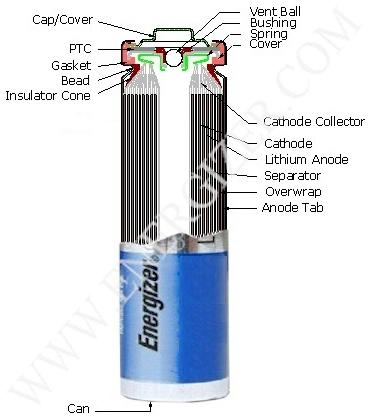
 ). Do this as quickly as you can because you may be short circuiting the battery. If it continues to short,
it'll heat up really badly in a few seconds and may catch fire. Cutting off the top will remove all the stuff in the positive terminal and make
life a bit easier. If its too slippery to cut, use the hack saw make a nice rough spot to start cutting.
). Do this as quickly as you can because you may be short circuiting the battery. If it continues to short,
it'll heat up really badly in a few seconds and may catch fire. Cutting off the top will remove all the stuff in the positive terminal and make
life a bit easier. If its too slippery to cut, use the hack saw make a nice rough spot to start cutting. ). Most of the Li will be already dark brown, but some of it that was wound deep in
the coil will still be metallic. Some of the dark brown stuff in the coil is very thin and sticks to the plastic. It sinks in the oil and is not Li
(thats the iron sulfide and it turns dark green in water). The Li is the thick sheet that floats in the oil. Some other crap in the coil includes a
sheet of aluminum foil.
). Most of the Li will be already dark brown, but some of it that was wound deep in
the coil will still be metallic. Some of the dark brown stuff in the coil is very thin and sticks to the plastic. It sinks in the oil and is not Li
(thats the iron sulfide and it turns dark green in water). The Li is the thick sheet that floats in the oil. Some other crap in the coil includes a
sheet of aluminum foil.
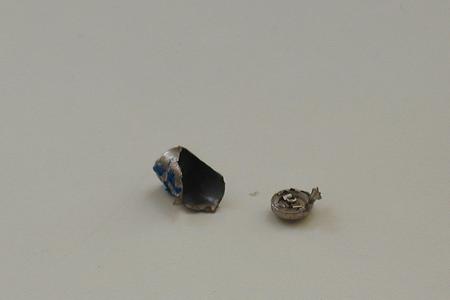
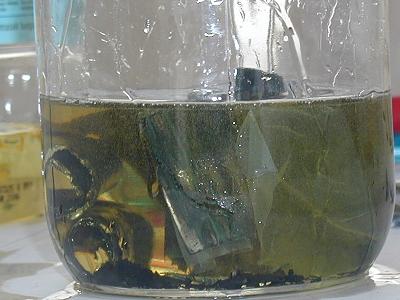
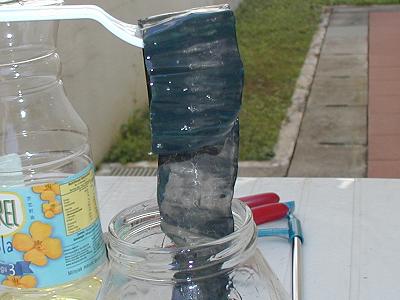

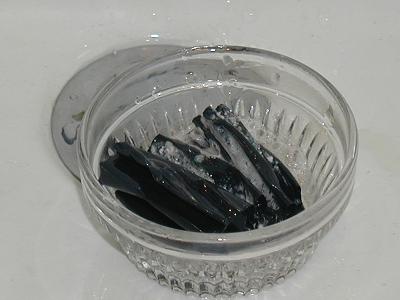













 Maybe its reacting with the
oil...
Maybe its reacting with the
oil...



 I
also have done this but I opened it on the wrong side not wanting any chance of shorting, primarily because my needlenose pliers have one tip broken
and I don't have many tools to handle it. When I did this, I had a plastic car wax top mostly filled with clear mineral oil (intended as a
laxative, with a bit of vitamin e, too) and I immersed the battery in it while working. If I needed to see it up close, I would use a dropper to keep
it soaked in oil, and of course I was wearing goggles. I learned soon enough that I couldn't use leather gloves for protection against heat, and
besides I would have no idea how hot it was until a spark or flame formed.
I
also have done this but I opened it on the wrong side not wanting any chance of shorting, primarily because my needlenose pliers have one tip broken
and I don't have many tools to handle it. When I did this, I had a plastic car wax top mostly filled with clear mineral oil (intended as a
laxative, with a bit of vitamin e, too) and I immersed the battery in it while working. If I needed to see it up close, I would use a dropper to keep
it soaked in oil, and of course I was wearing goggles. I learned soon enough that I couldn't use leather gloves for protection against heat, and
besides I would have no idea how hot it was until a spark or flame formed. ) but after a while they'd soak up some oil and their pores would become visible. I was SOOO freaked out while
doing this, not wanting to initiate any undersired reactions. Everytime I did, by shorting or pressing the Li against the black stuff (I thought it
was MnO<sub>2</sub> but not sure), I would usually see a red spark and take the battery outside in a glass container full of oil as far
from buildings as possible and quit for the night.
) but after a while they'd soak up some oil and their pores would become visible. I was SOOO freaked out while
doing this, not wanting to initiate any undersired reactions. Everytime I did, by shorting or pressing the Li against the black stuff (I thought it
was MnO<sub>2</sub> but not sure), I would usually see a red spark and take the battery outside in a glass container full of oil as far
from buildings as possible and quit for the night.

 But I dont recommend Theodore's way though, his battery kept on catching
fire
But I dont recommend Theodore's way though, his battery kept on catching
fire 
 He almost ran away from me when I showed him the Li
He almost ran away from me when I showed him the Li 





| Quote: |

| Quote: |



 It might've been from
bits of airborne particles of carbonate or it slowly reacting with the oil and making something volatile? It also could've been from something
in the battery and not the Li. There's something in there that smells really sweet and nice (if you take a whiff of the insides of the can,
you'll know what i mean). But whatever it was, it wasnt just me
It might've been from
bits of airborne particles of carbonate or it slowly reacting with the oil and making something volatile? It also could've been from something
in the battery and not the Li. There's something in there that smells really sweet and nice (if you take a whiff of the insides of the can,
you'll know what i mean). But whatever it was, it wasnt just me 

| Quote: |
| Quote: |

 Whats
the mask for though?
Whats
the mask for though? . I figured that while I was sawing open the battery,
all of the lithium oxidized. After collecting all of the iron sulfide by scraping it off of the Al roll, and putting it in a bottle with mineral oil,
getting rather aggrevated with my very poor quality lithium,
. I figured that while I was sawing open the battery,
all of the lithium oxidized. After collecting all of the iron sulfide by scraping it off of the Al roll, and putting it in a bottle with mineral oil,
getting rather aggrevated with my very poor quality lithium,  I noticed the
lithium roll. Ahh, that's what I was missing. This was rolled up and put in mineral oil.
I noticed the
lithium roll. Ahh, that's what I was missing. This was rolled up and put in mineral oil.
 I detected no ammonia smell.
I detected no ammonia smell.


 I didn't read the first
posts very carefully.
I didn't read the first
posts very carefully. I was making sure it *was* Li by by making
sure it reacted with water
I was making sure it *was* Li by by making
sure it reacted with water 


 Therefore I assumed you meant aqueous solution
Therefore I assumed you meant aqueous solution 
| Quote: |

| Quote: |

 How
much air is trapped in this wad
How
much air is trapped in this wad  So much for silver Li...
So much for silver Li...| Quote: |
 ...
... Quote: Originally posted by benzylchloride1  |